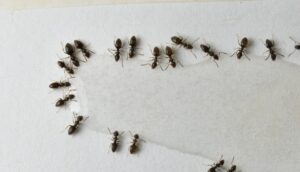
Ants are one of the most common household pests, and while they may seem small, they can quickly become a big problem. Once ants find a reliable food source inside your home, they leave a chemical trail that invites the entire colony to follow.
Understanding why ants invade and how to address the issue is the first step toward regaining control.
Why Ants Invade Homes
Ants are drawn indoors by four main factors:
- Available Food: Crumbs, sticky spills, and exposed pantry items, even small amounts, are magnets for ants.
- Water and Moisture: Leaky pipes, condensation, and damp spots offer hydration that certain ant species require.
- Shelter: Hidden spaces like wall voids or cluttered corners provide secure nesting sites.
- Easy Entry: Even the smallest cracks, gaps around doors and windows, or foundation voids offer access.
- Pheromone Trails: Once ants find a food source, they follow scent paths and reinforce the trail for others to join the raid.
DIY Strategies to Combat Ants
If you’ve seen a few ants around your home, it’s not too late to take action. By acting fast with effective strategies, you may be able to prevent a larger infestation.
- Disrupt Scent Trails: Clean surfaces with solutions like diluted vinegar or soapy water to erase ant scent trails. This discourages them from coming back, although results can be temporary.
- Homemade Bait Stations: Mix sugar with borax or baking soda to create bait that ants carry back to their nests. Be mindful: borax can be harmful if mishandled, especially around pets or kids.
- Natural Deterrents: Scents like cinnamon, essential oils, coffee grounds, and citrus peels can create temporary barriers by masking scent trails. You can also sprinkle food-grade diatomaceous earth around entry points. This abrasive substance dehydrates ants, but use it with caution and sparingly. When inhaled, diatomaceous earth’s airborne particles can cause issues for elderly individuals or those with lung sensitivity.
- Immediate Contact Methods: In some outdoor settings, pouring boiling water directly into visible ant hills can reduce numbers, but it may only be a surface-level fix unless repeated.
- Use Chalk: Drawing chalk lines across entry points, around windows, doors, or pet feeding spots, can disrupt ant pheromone trails temporarily. This trick is harmless and inexpensive, though not a lasting fix.
Ready for pest, lawn, or sprinkler service?
Ready for qualified professionals to help keep your home, business, or lawn in pristine condition?
Get your home, lawn, and lake in pristine condition. Leave your information and we'll be in touch.
*During normal business hours. After hours calls will be returned the next business day.
At Home Fixes Aren’t Always Enough
While these home remedies can lower nuisance levels, many fail to fully solve the problem for the following reasons:
- Ants can create new trails when old ones are disrupted
- The queen often remains untouched, meaning the colony persists and could come back
- Some DIY ingredients pose safety risks if improperly handled
For persistent or advancing infestations, especially when ants reappear often or nests aren’t accessible, professional intervention is essential.
Don’t Let Ants Overrun Your Home
Short-lived DIY solutions might help at first, but lasting ant control requires the professionals, especially for resilient colonies. Sorko Services has the experience, tools, and responsible methods to eliminate infestations and keep your home ant-free for good.
Ready to make your home ant-proof? Reach out to Sorko Services today for a free quote and expert ant control solutions that really work.
Back to Ant Control